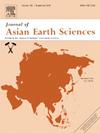Geochemical signatures and chemostratigraphic framework for the Early-Middle Permian sedimentary successions of Alborz, Iran
IF 2.4
3区 地球科学
Q2 GEOSCIENCES, MULTIDISCIPLINARY
引用次数: 0
Abstract
This research analyzes how the prevailing physicochemical conditions during the deposition of the carbonate intervals of the Ruteh Formation (Early-Middle Permian), in the Alborz, Iran, led to changes in water-column redox conditions. The significance of this study lies in providing unique insights into the oxic-anoxic variations in the Tethys Ocean during the detachment of the western Cimmerian microcontinent from Gondwana. The onset of interglacial periods and the opening of the Neo-Tethys in the Artinskian stage led to rising temperatures, oxic conditions, and a decrease in the enrichment factor and carbon isotope values. In contrast, the Kungurian oceans were suboxic to anoxic, as evidenced by positive carbon isotope values, high enrichment factor, positive Eu and Ce anomalies, and increased primary productivity. These geochemical changes are attributed to volcanic activities in the Early Kungurian, followed by the transgression of seawater during the opening of the Neo-Tethys and the movement of the Cimmerian microcontinent in the Late Kungurian. These factors played a crucial role in the development of oxygen-deficient basins and the upwelling processes. During the Roadian stage, oxic conditions once again dominated in the basin. The increase in temperature, coupled with the Cimmerian microcontinent’s movement towards equatorial latitudes, may have been a significant factor contributing to the decrease in carbon isotopic values, enrichment factor, and productivity proxies. The results obtained extend beyond previous studies, demonstrating that the deposition of the Ruteh Formation was closely linked to global events.
伊朗Alborz早-中二叠世沉积序列地球化学特征及化学地层格架
本研究分析了伊朗Alborz地区Ruteh组(早-中二叠世)碳酸盐层段沉积期间的主要物理化学条件如何导致水柱氧化还原条件的变化。本研究的意义在于对西锡梅里亚微大陆与冈瓦纳分离期间特提斯洋的氧-缺氧变化提供了独特的见解。间冰期的开始和Artinskian期新特提斯的打开导致了温度升高、氧条件升高、富集因子和碳同位素值降低。而昆古里亚海洋则呈现亚氧-缺氧特征,表现为碳同位素正、富集系数高、Eu和Ce正异常、初级生产力增加。这些地球化学变化归因于早昆古里安的火山活动,随后是新特提斯打开期间的海水海侵和晚昆古里安西米里亚微大陆的运动。这些因素在缺氧盆地的发育和上涌过程中起着至关重要的作用。在鲁甸期,盆地再次处于缺氧条件下。温度升高,再加上西梅里亚微大陆向赤道纬度移动,可能是导致碳同位素值、富集因子和生产力指标下降的重要因素。所获得的结果超越了以往的研究,表明Ruteh组的沉积与全球事件密切相关。
本文章由计算机程序翻译,如有差异,请以英文原文为准。
求助全文
约1分钟内获得全文
求助全文
来源期刊

Journal of Asian Earth Sciences
地学-地球科学综合
CiteScore
5.90
自引率
10.00%
发文量
324
审稿时长
71 days
期刊介绍:
Journal of Asian Earth Sciences has an open access mirror journal Journal of Asian Earth Sciences: X, sharing the same aims and scope, editorial team, submission system and rigorous peer review.
The Journal of Asian Earth Sciences is an international interdisciplinary journal devoted to all aspects of research related to the solid Earth Sciences of Asia. The Journal publishes high quality, peer-reviewed scientific papers on the regional geology, tectonics, geochemistry and geophysics of Asia. It will be devoted primarily to research papers but short communications relating to new developments of broad interest, reviews and book reviews will also be included. Papers must have international appeal and should present work of more than local significance.
The scope includes deep processes of the Asian continent and its adjacent oceans; seismology and earthquakes; orogeny, magmatism, metamorphism and volcanism; growth, deformation and destruction of the Asian crust; crust-mantle interaction; evolution of life (early life, biostratigraphy, biogeography and mass-extinction); fluids, fluxes and reservoirs of mineral and energy resources; surface processes (weathering, erosion, transport and deposition of sediments) and resulting geomorphology; and the response of the Earth to global climate change as viewed within the Asian continent and surrounding oceans.
 求助内容:
求助内容: 应助结果提醒方式:
应助结果提醒方式:


